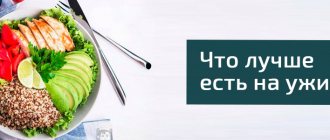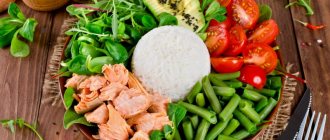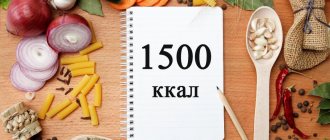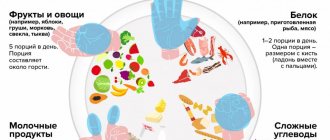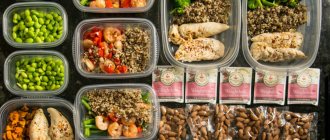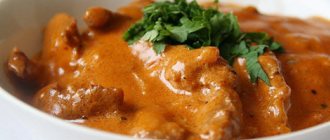Eating right every day
Proper nutrition begins with a balanced breakfast, which will contain proteins, fats and complex carbohydrates, as well as vitamins and minerals. This applies to both the three main meals and snacks.
Breakfast rules
The morning meal is the most important.
You can’t skip it, it doesn’t help you lose weight. On the contrary, there is a risk of getting better. In the morning, the level of the stress hormone cortisol is higher. It is produced so that a person can wake up. After eating, cortisol levels begin to decrease. If a person does not have breakfast, the body perceives this as a threat. And it begins to put aside nutrients “in reserve”, hence the extra pounds. The principle of breakfast is a balanced composition: proteins should be 20-40%, complex carbohydrates - up to 20%, the rest - healthy fats. Basic Rules:
· the energy value of breakfast for women is 300-400 kcal, for men - 400-500 kcal, depending on lifestyle;
· whole grain porridges (for example, oatmeal) should be boiled in water, but so that the carbohydrates they contain do not sharply increase the level of glucose in the blood, combine them with protein and fats - for example, eggs or hard cheese;
· If you want to treat yourself to sweets, you can eat a banana or a piece of chocolate after breakfast, provided that they are neutralized by the proteins and fiber contained in the vegetables.
A healthy breakfast can be quite filling, especially in winter. This meal should include the maximum amount of fat, because it takes a long time to digest. Even if you don’t like breakfast and have weaned yourself off it, you need to gradually get used to morning meals again. But dinner should really be light.
Snack rules
Proper nutrition consists of three main meals and two snacks. Their volume depends on how much time passes between the main techniques. It is advisable that this interval be no more than 3 hours. Energy value - up to 200 kcal. Snack products:
· apples - they contain many vitamins and antioxidants and can be eaten baked (add cinnamon rather than sugar to enhance the taste);
· bananas as a source of potassium for the cardiovascular system;
· red bell pepper (but only in season) - it contains a lot of vitamin A and ascorbic acid;
· pumpkin seeds - they contain calcium, magnesium, iron and zinc;
· oatmeal - if you didn't eat it for breakfast, you can include this dish in the menu for a snack and serve it with cinnamon and apple or with berries.
Any green vegetables are suitable for a snack. But fast food should be avoided.
Healthy lunch rules
Proper nutrition assumes that at lunch the energy value of the diet will be no more than 400-500 kcal. The rules are simple:
· vegetables should make up at least half of the total volume;
Fast food products must be avoided;
· Be sure to include fats and fiber in your diet.
You shouldn't eat dessert after lunch. But you can drink a glass of dried fruit compote or fruit juice.
Healthy Dinner Rules
It is important to eat right in the evening. The rules are simple:
· You can have dinner after 6 pm, but at least 2.5-3 hours before going to bed, so as not to feel hungry;
· dinner should be the lightest meal of the day, at this time the metabolism slows down, and hearty meals will only cause a heaviness in the stomach;
· the balance of proteins, fats and carbohydrates must be maintained; in the evening it is better to consume easily digestible proteins (for example, seafood) and fiber;
· energy value - no more than 20% of the daily diet.
The evening menu may also include whole grain cereals, legumes, fruits and vegetables. It is better to refuse bread or baked goods.
What not to eat for dinner
For dinner, you should avoid eating fried foods, fast food, bread and rice. These foods increase your glycemic load and store fat. Refined foods, sausages, sauces high in fat and sugar, white bread and whole grain pasta are also prohibited. Foods high in sugar, such as baked goods, sweet dairy products, store-bought juices, cookies or ice cream, are also undesirable.
PP dinner options include low-fat, high-protein foods.
Basic principles of diet planning
You can come up with different menu options. But it is necessary to adhere to the basic principles of diet planning:
1. Do not include fast food, smoked meats and fatty meats on the menu.
2. Choose seasonal products - they contain more vitamins and less agricultural chemicals, which are used to treat plants in greenhouses and fruits during transportation.
3. Limit the consumption of refined oils, premium flour, white rice, because they retain fewer nutrients.
4. Drink more clean water. Although it is believed that tea, coffee or fruit drink will not replace water, you need to approach this problem individually. A person needs approximately 35 ml per kilogram of weight per day. If he cannot drink that much water, you can include fruit drink or juice, but not sweet soda - you will have to completely abandon these drinks.
5. Protein foods are very important. It gives you a feeling of fullness for a long time and helps restore strength after a working day. But protein isn't just about eggs and meat. To diversify your diet, you can include legumes, nuts, and fermented milk products.
Proper nutrition also means preparing dishes in accordance with certain requirements. The less heat treatment a product undergoes, the more nutrients it retains. Italian pasta made from durum wheat is cooked al dente; it always remains a little undercooked. Nutritionists suggest cooking cereals using this principle. And you can season pasta and porridge with vegetable oil.
The only foods that definitely need to undergo serious heat treatment are meat and fish, as they may contain harmful bacteria. But you still can’t fry them. You can boil, steam or bake in the oven with spices - it will turn out delicious.
You can use more than just olive and sunflower oil for cooking. Sesame, nut and flaxseed oils give the dish a piquant taste. You can keep several bottles of different oils in your kitchen at once. But you can't fry them. Firstly, frying should be avoided altogether if you eat properly. Secondly, unrefined oils should not undergo heat treatment.
For cooking, you can use not only fresh, but also frozen food. The latter retain all useful properties. You should avoid semi-finished products and shelf-stable products, because they may contain flavor enhancers, food colorings, and preservatives. Their consumption will negate all efforts to maintain a proper diet.
PP dinner: options
Below you can find out what to cook for dinner PP. Anyone who is interested in what they eat for dinner with proper nutrition will find a suitable recipe for themselves.
Pasta with tuna and pesto sauce
An original and quick recipe for those who are wondering what to cook for dinner with proper nutrition.
Ingredients:
- 7 tablespoons pesto sauce;
- 320 g pasta;
- 2 cans (150 g) tuna;
- A handful of fresh spinach;
- Salt and extra virgin olive oil.
Preparation:
- Cook and cool the pasta.
- Place pasta in a large bowl and add pesto.
- Crumble the tuna with a fork and add to the pasta.
- In another container, season the spinach with oil and salt.
- Add pasta and mix everything.
- Let the salad sit in the refrigerator for about 30 minutes.
Hot salad with vegetables and chicken
This recipe is a great example of how easy it is to incorporate steamed foods into your diet. A good option for people who want to prepare a healthy dinner while maintaining proper nutrition.
Ingredients:
- 150 g chicken breast;
- 100 g zucchini;
- 100 g broccoli;
- 100 g mushrooms;
- Salt, garlic powder and soy sauce (to taste).
Preparation:
- Rinse the vegetables well. Cut the zucchini into slices, and the broccoli and mushrooms into pieces.
- Place everything in a microwave-safe bowl.
- Add two tablespoons of water.
- Cover with transparent film and make small holes.
- Place the dish in the microwave for 5 minutes.
- Grill the chicken.
- Chop and add to vegetables.
- Season the dish with salt, garlic powder or a little soy sauce.
Pasta with tomatoes, feta cheese and olives
A good option for those who are interested in what they can have for dinner if they eat properly.
Ingredients:
- 200 g cherry tomatoes;
- 300 g pasta;
- 100 g diced feta cheese;
- 150 g black olives;
- Salt and pepper;
- Extra virgin olive oil.
Preparation:
- Cook and cool the pasta.
- Cut the tomatoes in half, place in a bowl and add salt.
- Add feta cheese, olives, pasta, chopped basil leaves and oil.
- Stir and leave in the refrigerator for half an hour.
Ratatouille
A delicious vegetable-based dish. This is a fairly simple and healthy dinner - proper nutrition will not be disrupted with it.
Ingredients:
- 1 eggplant;
- 2 zucchini;
- 2 tomatoes;
- 2 green bell peppers;
- 2 cloves of garlic;
- 1 large onion;
- Extra virgin olive oil;
- Salt;
- Provençal herbs (oregano, rosemary, thyme, basil, marjoram, etc.).
Preparation:
- Cut the eggplant into thin slices and place them in a colander.
- Turn on the oven to preheat at 180°C.
- Chop the remaining vegetables.
- Use a baking dish with high edges.
- Arrange the vegetable slices in a spiral, starting from the edge of the tray, one after the other towards the center, until a spiral is formed.
- In a bowl, mix about 3-4 tablespoons of oil with Provençal herbs and chopped garlic. Use the dressing.
- Place the vegetables in the oven. Cook them for about 40 minutes.
- Baked sea bass
PP soups for weight loss
There are also dietary soups, they differ not only in that they contain few calories, but also in their high fiber content, which cleanses our intestines of toxins. So, what needs to be added to the soup to make it dietary:
- celery. Soups with the addition of celery have always been considered dietary dishes; there are even fasting days on celery soups.
- beet. It gently cleanses the intestines and helps normalize the functioning of the gastrointestinal tract. PP borscht is an excellent version of this soup.
- green beans. Another healthy and low-calorie ingredient. There are only 31 calories in 100 grams of beans.
How to accustom yourself to proper nutrition?
To accustom yourself to a balanced diet, you need to plan your menu in advance, buy and prepare food. To make dishes varied and tempting, nutritionists recommend experimenting with spices and combining different foods. You should leave 1-2 favorite treats in your diet. The “correct” sweets allowed in small quantities are dark chocolate, apple marshmallows, natural jellies, marmalades and ice cream, dried fruits.
To cope with hunger during the day, you are allowed to eat unlimited amounts of negative-calorie vegetables and fruits. These foods are rich in plant dietary fiber, so when digesting them, the body spends more energy than it receives. These include:
- celery;
- rhubarb;
- cabbage;
- cucumbers;
- asparagus;
- radish;
- green apples;
- pineapples;
- all types of greens and leafy salads.
You are allowed to drink kefir before going to bed.
A balanced diet is the basis for a high quality of life, health and active longevity.
How to eat healthy for breakfast, lunch and dinner
A product that is healthy in itself and eaten at the wrong time will, at best, simply not bring any benefit. The regime is also important because irregular meals are stressful for the body, due to which it begins to store fat in reserve. In addition, there are fasting days, therapeutic fasting and other extreme methods of losing weight.
When to get up?
Scientists have proven the connection between sleep patterns and body fat percentage. If a person goes to bed and gets up at the same time every day, this not only has a good effect on his psychological state, but also has a positive effect on his figure. In addition, the duration of sleep is also important. Those who sleep about 8 hours a day have the lowest percentage of body fat. So, we conclude: for good health and appearance, it is important to always get up at the same time and get enough sleep.
What's for breakfast?
Many have already heard about the importance of breakfast. It is essential for a successful active day. If breakfast is not high enough in calories, then you simply will not have the energy to work, study, exercise, or anything else that you have planned for the first half of the day. And if it is excessive, then the body will devote all its energy to digesting food and then you will be in a sleepy state for half a day.
That is why experts recommend eating foods with so-called long-term carbohydrates and proteins for breakfast. Simply put, I porridge with milk. Or bread and cheese. But here, of course, the quality of the products is of great importance. Do not take one-minute oatmeal: after the processing it has undergone, it can no longer be called a complex carbohydrate. The bread must be whole grain. Low-fat hard cheese is suitable for breakfast; it is easily digestible.
Some people say that they simply cannot eat in the morning. In this case, it is recommended to have dinner 4 hours before bedtime. This will make you sleep better, and you will be more likely to want to eat in the morning. In addition, you can get up a little earlier than usual to prepare breakfast, if not for yourself, then for your household. It is quite possible that the aroma and pleasant appearance of food will awaken your appetite too.
Snacking is allowed!
You had a hearty breakfast, but it’s far from lunch and you’re hungry? In this case, a snack is necessary. There is an opinion that snacking is harmful because it interrupts the appetite, and then a person does not eat nutritious food. But the opposite is also true: without a snack, you are so hungry that you overeat during the main meal. There is little good in this either.
The golden mean is in the right snack. Firstly, it should not be plentiful: 10% of the daily requirement of kilocalories. For a healthy person, this is approximately 200 kilocalories (2000 per day, respectively). Secondly, the snack should be quite filling and not sweet. What could it be - small and satisfying? 30 grams of nuts, 50 grams of Parmesan, 300 grams of unsweetened yogurt with 3.2% fat, fresh vegetables with a little olive oil. And of course, it is very important to drink water. A small snack, a glass of water - and you can calmly wait for lunch.
It's time to have lunch
Lunch should be the busiest meal of the day. It accounts for approximately 45% of the total daily calorie intake. Just like breakfast, it should be satisfying so that you can successfully complete your work day. But at the same time, there is no need to overdo it, because not every office has the now fashionable sleep capsules.
Mandatory components of a proper lunch: soup, meat (poultry or fish) and a side dish in the form of vegetables or healthy carbohydrates (buckwheat, wild rice). Soup improves peristalsis and helps you feel full, meat gives you strength, vegetables help digest meat, complex carbohydrates will help you last until dinner. At the same time, of course, we must not forget about the taste of the food, because lunch should delight, and not just be a boring meal.
Proper dinner
Good news: the “don’t eat after six” rule applies only to those who go to bed at 10. As we have already said, it is best to have dinner 4 hours before bedtime, and just before bed you can drink a glass of kefir. For dinner, it is best to eat a light protein dish, such as turkey, and cooked vegetables. Such food is easily digested and does not interfere with restful sleep.
Another correct option is cottage cheese. Moreover, it does not have to be eaten with something sweet like jam. You can cut some greens or some fruits into it.
Proper nutrition: lunch, tips and tricks
Having decided to change your eating habits, it is important not to lose by the end of the week the enthusiasm that always occurs at the beginning of a planned undertaking, and to come up with suitable dishes in advance:
- It is best to make a list of products that are considered “allowed” and are easily combined with each other;
- you should purchase and keep on hand a minimum energy reserve that can provide a proper lunch and prevent a breakdown;
- it would be useful to boil foods in advance that can be easily assembled into a tasty and healthy dish if necessary;
- Once a week it’s a good idea to spend time preparing “proper” cookies or other sweets that can be stored for several days;
- Do not try to change long-term habits and tastes from the first day. Most likely, this will cause complete rejection of the idea. It is much more productive to review the old menu and try to replace unsuitable components with their healthy counterparts.
Note! During adolescence, a child often consumes food that is “fashionable” in his environment: chips, sparkling water, store-bought sweets or baked goods. It can be difficult to control and prohibit such actions
But it is quite possible to involve him in the search for healthy recipes and get him interested in cooking together.
Sample menu for a week with a balanced diet
Monday:
- breakfast - cottage cheese with dried fruits, tea;
- 2nd breakfast - yogurt, orange;
- lunch - buckwheat, boiled meat, vegetable salad, slice of whole grain bread;
- afternoon snack - a handful of almonds, pomegranate juice;
- dinner - vegetable stew.
Tuesday:
- breakfast - porridge with fruits or berries, cheese, tea;
- 2nd breakfast - baked apple with honey and nuts;
- lunch - vegetable soup, baked cod, a slice of whole grain bread;
- afternoon snack - kefir;
- dinner - boiled chicken, Greek salad.
Wednesday:
- breakfast - omelet, toast, fresh vegetables;
- 2nd breakfast - avocado;
- lunch - mushroom soup, spaghetti with pesto sauce;
- afternoon snack - cottage cheese;
- dinner - stewed rabbit meat, vinaigrette.
Thursday:
- breakfast - muesli with milk, cottage cheese dessert, herbal tea;
- 2nd breakfast - berries;
- lunch - soup with green peas, lasagna;
- afternoon snack - yogurt;
- dinner - salmon baked with spinach.
Friday:
- breakfast - oatmeal, rosehip decoction;
- 2nd breakfast - fruit smoothie;
- lunch - chicken broth, grilled vegetables;
- afternoon snack - cottage cheese;
- dinner - seafood and seaweed salad, a slice of rye bread.
Saturday:
- breakfast - toast with cream cheese, coffee with milk;
- 2nd breakfast - pomegranate;
- lunch - boiled veal, lobio;
- afternoon snack - assorted dried fruits;
- dinner - a slice of boiled turkey, vegetable salad with vegetable oil.
Sunday:
- breakfast - buckwheat porridge with milk;
- 2nd breakfast - hazelnuts;
- lunch - vegetable soup, steamed chicken breast, tomato salad, slice of bread;
- afternoon snack - grapefruit;
- dinner - carrot casserole.
How to cook PP soup
So, if you decide to cook soup on pp, then you should know the following subtleties:
- giving up potatoes. Often, potatoes are one of the most high-calorie ingredients in soup, so if you want a light soup with pp, then it is better to remove this ingredient altogether. If you can’t eliminate it completely, then reduce its use to a minimum.
- add legumes to soup. This will help replace potatoes.
- cook in vegetable broths. To get a delicious soup, it is not at all necessary to cook soups with meat broths. Using onions, carrots and a stalk of celery you can make a great base for a simple soup.
- Boil the meat separately. To make the soup healthier and less fatty and high in calories, it is better to boil the meat separately. Then you can disassemble it into fibers or cut it, and then add it to the soup in finished form.
- Avoid frying, as this immediately makes the soup more nutritious. Diet soups do not require frying vegetables.
- do not overuse seasonings and spices, because they increase appetite, and this is the least needed during a diet or proper nutrition.
- don't oversalt. Salt retains fluid and, as a result, swelling appears.
PP puree soup
There are also many recipes for low-calorie puree soups. Regular pureed soups are made with potatoes and a generous portion of heavy cream. Cream soup, of course, is prepared completely differently:
- Instead of potatoes, it is best to use pumpkin, cauliflower, and broccoli. Cauliflower is ideal if you really want to replace potatoes. 100 grams of this product contains only 25 calories, while potatoes contain 77! Pumpkin is a great option for autumn puree soup. In general, the good thing about puree soup is that you can add absolutely any vegetables to it to suit your taste!
- You can always add boiled lean meat to puree soup, then your soup will also become high-protein.
- Instead of heavy cream, you can add a little low-fat cow's milk or vegetable milk.

